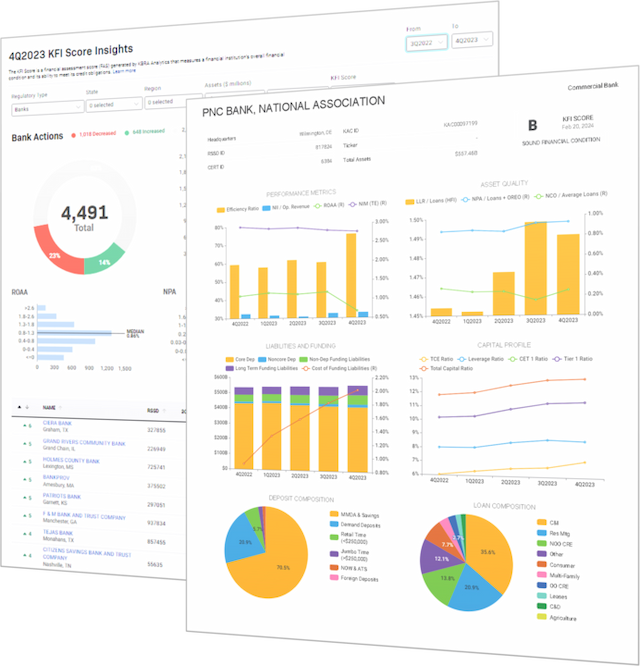KBRA Financial Intelligence
CRE Delinquency Rate Climbs to 10-Year High at Biggest Banks
By KFI Staff
The delinquency rate for commercial real estate (CRE) loans climbed to a 10-year high at the biggest banks in 4Q 2023 due to deteriorating loans tied to investor properties.
For banks with at least $100 billion in assets, the CRE delinquency rate increased to 1.82%, the highest since 4Q 2013, according to data compiled by KBRA Financial Intelligence (KFI). Overdue commercial properties are driving most of the stress, with the delinquency rate more than doubling to 3.94% from 1.56% in the period.

Delinquent loans are defined as the sum of 30-89 days past due loans, 90+ days past due loans, and nonaccrual loans. Still, at this point in the cycle, the recent rise in delinquencies is well below that of the global financial crisis era.
Weak demand for office towers is driving the stress. The Federal Reserve’s latest beige book noted that the office market remains weak across much of the U.S. In the Southeast, a tenant-favorable market is forcing landlords to offer incentives so they can boost occupancy rates. Distressed office loans are the largest component of KBRA’s Loan of Concern (K-LOC) Index, which is KBRA Credit Profile’s primary metric to measure stress in the CMBS conduit market.

For all banks, CRE stress is rising, though not at the same speed as the biggest lenders, since smaller banks generally do not lend to large downtown office properties—the subsector most at risk. The delinquency rate for all lenders climbed to 1.07% in 4Q, up 10 basis points from the quarter earlier, according to KFI. Of the $33.9 billion of overdue CRE loans reported in 4Q, almost $21 billion was held by the biggest lenders.
Year-over-year CRE loan growth slowed to 2.9% in 4Q, the weakest pace in more than a year.
KFI Subscribers can access the Peer Comparison CRE Composition and Delinquency Analysis Excel file found in the template library.
KFI’s Market Volatility Scores: A Daily Liquidity Risk Measure
KFI has developed a market-based model that offers insights into the solvency of banking entities, which can serve as an early warning sign for potential defaults.
Market Volatility Scores (MVS) are our proprietary daily measure of a bank’s risk level relative to its peers, based partly on stock price, deposits, and market capitalization. Market Volatility Indices (MVI) aggregate MVS across large, regional, and community banks. Both MVS and MVI assess risk on a 0 (stable) to 100 (volatile) scale.
KFI developed its MVS and MVI in response to client demand for daily risk assessments following the March 2023 bank runs. The new daily risk assessments complement our quarterly KFI Scores.
Model highlights:
Based on three default risk models (Merton, KMV, and Bharath & Shumway) designed for nonfinancial institutions, with certain inputs revised to align with the banking sector.
Ranks publicly listed banks based partly on deposit composition, asset size, and equity volatility.
Assesses whether a bank’s default risk is above or below the average of its peer group.
From 2019 to 2023, community banks exhibited the highest volatility scores while the largest lenders displayed the lowest, with regional banks in between those two poles.
The below chart shows MVS scores of seven lenders during the March 2023 bank runs, capturing elevated risk across the sector. Among the example lenders, PacWest Bancorp.’s MVS jumped the most, to 97 from 46. In July 2023, the bank was acquired by Banc of California.
Recent M&A
Sound Credit Union (KFI Score: B), a $2.9 billion lender in Tacoma, Washington, agreed on March 11 to buy Washington Business Bank (KFI Score: A-) for $34 to $36 a share. The transaction, which is expected to close in the Q4, will create a $3 billion credit union with 27 branches.
Southern States Bank (KFI Score: B+) and its holding company agreed on February 28 to acquire CBB Bancorp and its Century Bank of Georgia (KFI Score: B+). Alabama-based Southern States Bank will have $2.8 billion in assets after the deal closes, which is expected in Q3.
3 Things in Credit Podcast
Listen to 3 Things in Credit, a weekly podcast hosted by KBRA’s Chief Strategist Van Hesser. From the March 22 episode:
“The well-off continue to spend, confident in their record levels of net worth. Much of the middle class continues to borrow (and spend) because they are secure in their employment prospects and positive growth in real wages. Those with a more tenuous financial situation are self-regulating—i.e., spending and borrowing less—in order to shore up their financial wherewithal. All of this squares up with a soft-landing scenario.”
